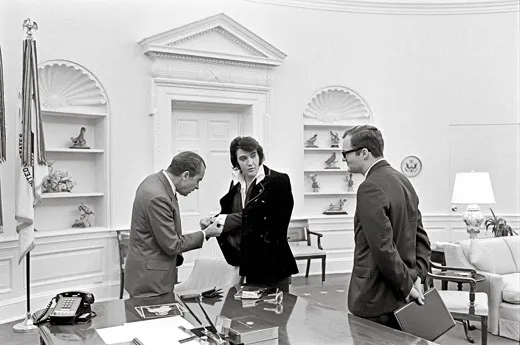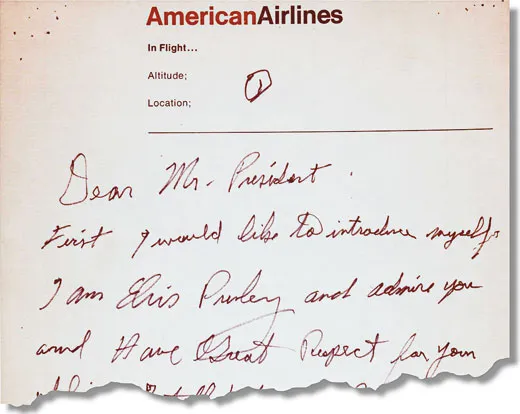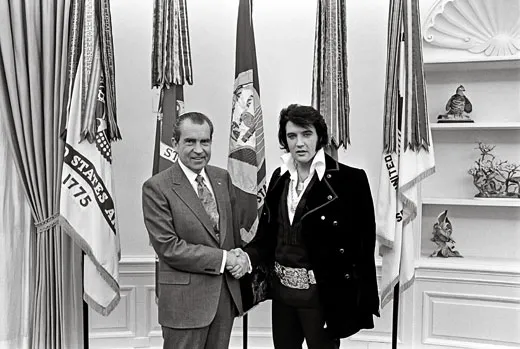When Elvis Met Nixon
An Oval Office photograph captured the bizarre encounter between the king of rock and roll and the president
/https://tf-cmsv2-smithsonianmag-media.s3.amazonaws.com/filer/Indelible-Nixon-Elvis-631.jpg)
The image looks like a computer-generated joke, or maybe a snapshot from some parallel universe where the dead icons of the 20th century hang out together—even Elvis Presley and Richard Nixon.
But the picture is genuine, an official White House photograph of a bizarre encounter that occurred in this universe, in the Oval Office on December 21, 1970.
The story began in Memphis a few days earlier, when Elvis' father, Vernon, and wife, Priscilla, complained that he'd spent too much on Christmas presents—more than $100,000 for 32 handguns and ten Mercedes-Benzes. Peeved, Elvis drove to the airport and caught the next available flight, which happened to be bound for Washington. He checked into a hotel, then got bored and decided to fly to Los Angeles.
"Elvis called and asked me to pick him up at the airport," recalls Jerry Schilling, Presley's longtime aide, who dutifully arrived at the Los Angeles airport at 3 a.m. to chauffeur the King to his mansion there.
Elvis was traveling with some guns and his collection of police badges, and he decided that what he really wanted was a badge from the federal Bureau of Narcotics and Dangerous Drugs back in Washington. "The narc badge represented some kind of ultimate power to him," Priscilla Presley would write in her memoir, Elvis and Me. "With the federal narcotics badge, he [believed he] could legally enter any country both wearing guns and carrying any drugs he wished."
After just one day in Los Angeles, Elvis asked Schilling to fly with him back to the capital. "He didn't say why," Schilling recalls, "but I thought the badge might be part of the reason."
On the red-eye to Washington, Elvis scribbled a letter to President Nixon. "Sir, I can and will be of any service that I can to help the country out," he wrote. All he wanted in return was a federal agent's badge. "I would love to meet you," he added, informing Nixon that he'd be staying at the Washington Hotel under the alias Jon Burrows. "I will be here for as long as it takes to get the credentials of a federal agent."
After they landed, Elvis and Schilling took a limo to the White House, and Elvis dropped off his letter at an entrance gate at about 6:30 a.m. Once they checked in at their hotel, Elvis left for the offices of the Bureau of Narcotics and Dangerous Drugs. He got a meeting with a deputy director, but not approval for a bureau badge.
Meanwhile, his letter was delivered to Nixon aide Egil "Bud" Krogh, who happened to be an Elvis fan. Krogh loved the idea of a Nixon-Presley summit and persuaded his bosses, including White House Chief of Staff Bob Haldeman, to make it happen. Krogh called the Washington Hotel and set up a meeting through Schilling.
Around noon, Elvis arrived at the White House with Schilling and bodyguard Sonny West, who'd just arrived from Memphis. Arrayed in a purple velvet suit with a huge gold belt buckle and amber sunglasses, Elvis came bearing a gift—a Colt .45 pistol mounted in a display case that Elvis had plucked off the wall of his Los Angeles mansion.
Which the Secret Service confiscated before Krogh escorted Elvis—without his entourage—to meet Nixon.
"When he first walked into the Oval Office, he seemed a little awe-struck," Krogh recalls, "but he quickly warmed to the situation."
While White House photographer Ollie Atkins snapped photographs, the president and the King shook hands. Then Elvis showed off his police badges.
Nixon's famous taping system had not yet been installed, so the conversation wasn't recorded. But Krogh took notes: "Presley indicated that he thought the Beatles had been a real force for anti-American spirit. The President then indicated that those who use drugs are also those in the vanguard of anti-American protest."
"I'm on your side," Elvis told Nixon, adding that he'd been studying the drug culture and Communist brainwashing. Then he asked the president for a badge from the Bureau of Narcotics and Dangerous Drugs.
"Can we get him a badge?" Nixon asked Krogh.
Krogh said he could, and Nixon ordered it done.
Elvis was ecstatic. "In a surprising, spontaneous gesture," Krogh wrote, Elvis "put his left arm around the President and hugged him."
Before leaving, Elvis asked Nixon to say hello to Schilling and West, and the two men were escorted into the Oval Office. Nixon playfully punched Schilling on the shoulder and gave both men White House cuff links.
"Mr. President, they have wives, too," Elvis said. So Nixon gave them each a White House brooch.
After Krogh took him to lunch at the White House mess, Elvis received his gift—the narc badge.
At Elvis' request, the meeting was kept secret. A year later, columnist Jack Anderson broke the story—"Presley Gets Narcotics Bureau Badge"—but few people seemed to care.
In 1988, years after Nixon resigned and Elvis died of a drug overdose, a Chicago newspaper reported that the National Archives was selling photos of the meeting, and within a week, some 8,000 people requested copies, making the pictures the most requested photographs in Archives history.
These days, the Archives gift shop sells T-shirts, coffee mugs, refrigerator magnets and snow globes emblazoned with the image. And Chris DerDerian, the Archives' director of retail, is thinking of adding an Elvis-Nixon souvenir charm.
Why is the photo so popular? DerDerian figures it's the incongruity: "There's this staid president with this rock 'n' roll figure. It's a powerful image."
Krogh agrees. "It's a jolt seeing them together. Here is the leader of the Western world and the king of rock 'n' roll in the same place, and they're clearly enjoying each other. And you think, 'How can this be?'"
Peter Carlson is the author, most recently, of K Blows Top, a travelogue on Nikita Khrushchev's 1959 tour of the United States.


